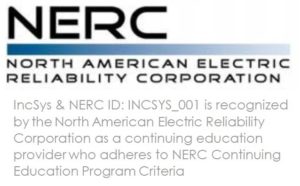 Introduction to Grid Management Systems
Introduction to Grid Management Systems
Course NERC Continued Educational Hours: OT: 6; Stand: 0; SIM: 3
This is a NERC Continued Educational computer-based training module which consists of several video lectures and simulation exercises. The instructor presents a lecture on the evolution of Energy Managements system starting with Analog AGC systems in 1950’s, through first Digital AGC/SCADA systems in 1960’s first generation EMS in 70’s to 90’s and second-generation systems in 2000’s. The lecture also covers the evolution of master station to substation communications including first generation discrete component Remote Terminal Units (RTUs), second generation computer based RTUs and third generation distributed Intelligent Electronic Devices (IEDs). Grid management applications that are recommended by NERC for maintaining network reliability are also explained where they cover new reliability applications that consider system dynamic response and use PMU data. Some challenges in sharing models and upgrading legacy Energy Management Systems are also covered. The instructor lectures from the EPRI report on Grid Operating Systems 3.0. and covers power system changes such as: distributed generation, electric vehicles, increased renewables and distributed controls and how these changes are necessitating a new generation of Grid Monitoring, Control and Analysis Systems. The characteristics and behaviors of people with different levels of expertise from novice to expert or master are explained as well as the recognition primed decision model originally developed by Dr. Gary Kleni that has been adapted to describe how system operators develop situational awareness and make decisions. Students will learn the basic functionality of the power simulator features in this lecture as well as operate it with detailed step by step instructions and build a cranking path from a generator which has the capability to run back to house load after a system disturbance. After the secondary steam unit is synchronized, the student will add load in controlled steps to bring both units up to their minimum operating level while keep the frequency deviations within limits.
PALCO 100 – Course Objectives
Introduction to Grid Management Systems
- Describe the evolution of Energy Management systems from the 1950’s to present.
- Describe the evolution of master station to substation communications.
- Operate the simulator on a power system model.
- Detect voltage violations and branch overloads on the system overview map.
- Start, stop and re-dispatch generation as well as monitor and control the load.
- Navigate between the wide area system map and the detail of station diagrams.
- Apply the make before break rule to take a substation bus out of service.
- List and describe the purpose of applications that are used for maintaining network reliability.
- Describe the next generation applications that consider system dynamic response and use PMU data.
- Describe challenges in sharing models and upgrading legacy Energy Management Systems.
- Describe how distributed generation, electric vehicles, increased renewables and distributed controls are changing tomorrow’s power systems.
- Describe how these changes are necessitating a new generation of Grid Operating System.
- Operate the simulator to build a cranking path from a generator which has the capability to run back to house load after a system disturbance.
- Using the simulator, start and synchronize a secondary steam unit.
- List and describe the characteristics and behaviors of people with different levels of expertise from novice to expert or master.
- Draw a flow diagram of a process that can be used to describe how system operators develop situational awareness and make decisions.
- Operate the power system simulator to implement the steps to remove components from service.
- Locate reactive resources (shunt reactors, shunt capacitors, static VAR compensators, etc) in the system.
- Using the simulator, verify a switching order as correct or incorrect.
- Identify proper switching protocols and good procedural practices.
Downloadable PALCO 100 Course Flyer
Subject Matter Expert
This course listed is a NERC CE approved continuing education course which will help you obtain the required NERC CE Credit Hours for maintaining the validity of your NERC Certification.
End of Course Instructions
After successful completion of the course the certificate of completion will be available for download and print from your training homepage.
After successful completion of this course your credits will be automatically reported for NERC CE Credits via the NERC SOCCED reporting tool. IncSys Academy also has a policy where credits will be manually reported via SOCCED on a WEEKLY basis (every Monday). It is critical that each candidate provide IncSys Academy with their proper credentials to ensure that proper credits are reported to your SOCCED account. Please contact our team at 425.732.2377 X 3 or via email at calvin.kaiser@incsys.com to report any NERC CE credit items needed for resolution.
Quiz & Simulation Information
There are quizzes and simulation exercises in this course module which must be passed with a MINIMUM grade of 75% to complete the course. Please check your grade report to ensure that you have achieved a passing grade of at least a 75% for each graded area.
IncSys Non-Refundable Policy
Clients who purchase training from the IncSys Academy catalog portal are Non-Refundable from the date of payment. Please ensure that you copy and save your receipt order prior to closing out your purchase order payment.
